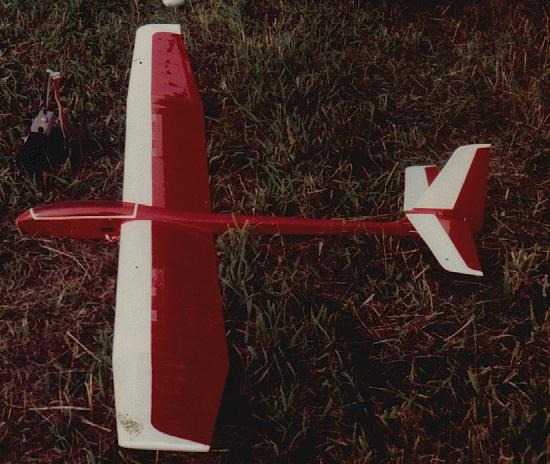Chapter 10: Nostalgia Sailplanes
These planes were designed and built in the early days of sailplane flying, when built-up balsa construction was the norm. Many of the planes reviewed here may be available either in hobby stores or from individuals. The AMA recently created a class for nostalgia sailplanes in which you can compete against other nostalgia planes.
10.1 Aquila

I built my first Aquila in the winter of 1979-1980 and flew it in competition the next two years. I even placed with it once. The kit had the outstanding quality Airtronics was known for at the time --machine cut parts, complete hardware, high quality wood -- the works. It was a great plane - very docile with excellent handling characteristics. Though the plane would now be considered a gasbag due to its flat airfoil and poor heavy wind performance, it is still a great plane.
The Aquila is no longer in production, but because so many were sold over the years, kits and planes can still be purchased on the used market. There are also rumors that Whyte Wings, who recently re-released the Olympic II, may eventually re-kit this classic sailplane.
Recommended modifications and building tips:
- Care must be taken when shaping the built-up wood fuselage. I remember some people sanding too much material away, creating a weak spot in the fuselage behind the wing.
- The wing rod system in the Aquila was where most Aquila's failed on launch. The wings slide onto the main rod that passes through the fuselage, and are held only by friction or a little masking tape. When stressed, the wing usually pulled away from the fuselage and then bent the wing rod at the fuselage-wing joint. Some kind of metal clip on the top and bottom to keep the wings from sliding on the rod would be a great addition.
- A lot of controversy surrounds the infamous "Miller mod" that Skip Miller made to the airfoil prior to the 1976 US finals. Skip Miller supposedly added a Phillips entry to the flat-bottomed Aquila airfoil that improved its performance in the finals. Skip recently posted a message to RCSD (17 Nov 97) clarifying his reasons for the modification. According to Skip, three days before the final he had serious wing flutter problems with the Aquila. The original Aquila had only 1/2 D-tube construction, which means it had 1/16" balsa sheeting on the top forward third of the wing only. Skip at the last minute decided to sheet the bottom with 1/16" balsa back to the spar, and let the monokote hang free the rest of the way back to the TE. He made his modification to one wing, hand launched it, and then modified the other and entered the Denver finals. With absolutely no practice flights on his modification, Skip placed second in the finals and went on to win the world championship. The sheeting stopped his wing flutter problems on the speed runs. Crossections of Skip's new airfoil were supposedly used as a template for the Aquila Grande flown by US team members in the 1979 championships.
- Other than the above mentioned modifications, I'd leave the Aquila alone -- it's a great plane.
10.2 Pierce Paragon
The Paragon represents one of the finest open class "floaters" ever designed. At 120" and weighing in at only 48 ounces, it was one of the real competitors in the "era of floaters" which lasted from the beginning of R/C soaring through the early eighties. The Paragon is a gentle, majestic thermal machine that performs very well in light lift and light wind. The Paragon has conventional wood construction, and a flat bottom airfoil. It pays to keep the plane fairly light, but the 48oz target weight is not hard to achieve using stock parts. I built my first Paragon in 1980, and it still flies great.It is a very easy plane to fly, and on a calm day can beat many of the state-of-the-art lead sleds, even in open competition. It is a great plane for competing extended thermal tasks, because it is easy to see from great distances and can be trimmed to thermal with little external input. I think it is the ideal plane for really long duration tasks such as the LSF Level IV and V (1 hour and 2 hour) thermal duration. Flying a full house lead-sled for two hours at fantastic distances is much harder than watching a Paragon fly itself. Naturally the Paragon suffers on windy days, due to its thick flat-bottom airfoil and slow flight speed. If you are looking for a big floater, however, the Paragon is one of the best ever built.
The Paragon is still available in kit form as of the time of this writing.
Recommended modifications and building tips:
- The wing joiners for outer panels are quite flimsy. At a minimum, wrap the joiners with strong thread, and try to get the joint tight. An alternative joiner -- thicker plywood or other material -- is probably a better solution.
- Build a ballast box in the fuselage -- this plane will take as much as two pounds of ballast, and certainly needs it on a windy day.
- Strengthen the wing by adding .007 carbon fiber cap strips to the top and bottom spars. I'm not entirely convinced this is needed, but it doesn't add much weight.
- My Paragon features a flying T-tail. While not needed, it makes the plane unique -- be creative! (Note - the T-tail is not currently nostalgia legal).
- The RCSE exchange has discussed more radical modifications to this plane, such as flaps, a Phillips entry on the airfoil, and so on. I personally think these people are missing the boat! This plane is the ultimate big, slow, light gas-bag, and one of the best ever built -- don't change it too much.